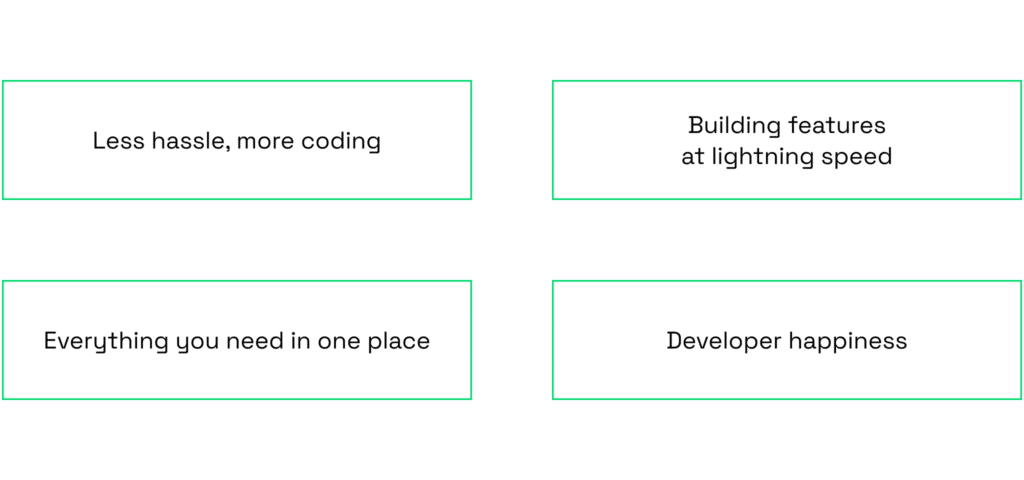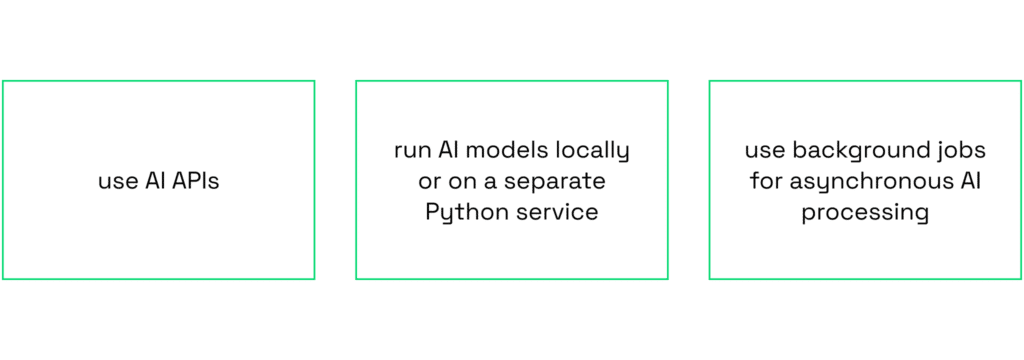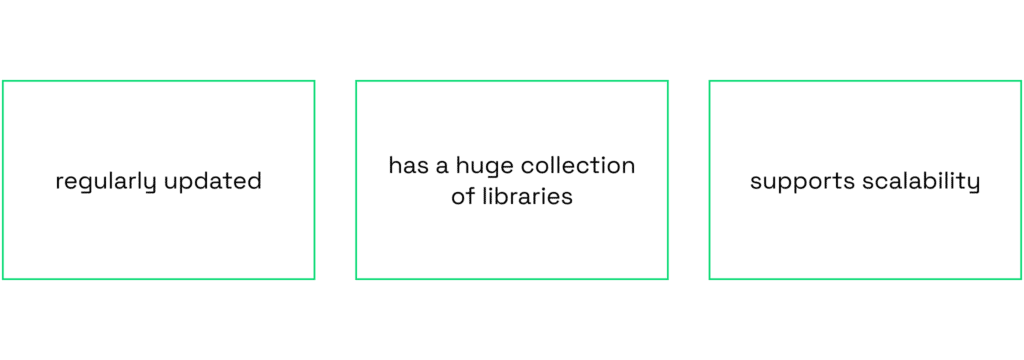If programming frameworks aged like smartphones, Ruby on Rails would have been “outdated” long ago. Yet it’s still here, powering startups, enterprises, and everything in between.
Rails isn’t about chasing trends. Its mission is to get things done quickly and efficiently with a proven, reliable approach.
And that’s actually what we are going to discuss in this blog post.
With over a decade of experience in the Rails framework since 2013, we know it inside and out. So, we’ll explore what makes it in demand, the key RoR trends 2025-2026, and how to integrate AI if your project is built with Ruby on Rails.
If you need an expert view provided by developers with a 10-year average experience in RoR web development, reach out to us and get a free project estimate.
Contents:
- How Ruby on Rails Works: Key Principles
- Top Ruby on Rails Trends
- How to Integrate AI on a Ruby on Rails Project?
- Is It Worth Using RoR in 2025?
- Summing Up
How Ruby on Rails Works: Key Principles
Rails is a powerful framework that is used for building different types of web applications, from simple MVPs to large-scale platforms, at quite high speed.
Instead of writing everything from scratch, it gives you ready-to-use tools so you can focus on creating great features. Built on the Ruby programming language, Rails makes web development easier and more efficient.
Let’s take a detailed look at the 4 principles of how RoR works.

1. Less Hassle, More Coding
One of Rails’ biggest philosophies is “Convention over Configuration” (CoC). Sounds fancy, but it simply means:
“Rails makes most of the decisions for you, so you don’t have to waste time setting up everything manually.”
Imagine it like ordering a burger at a restaurant. Instead of naming every single component you want, simply say, “I’ll have the classic burger,” and the chef will know what to include. That’s Rails in action: it uses smart defaults so you don’t have to specify every little element.
Other frameworks sometimes require extensive setup and configuration before starting coding. Rails, on the other hand, uses best practices by default, which speeds up and improves development efficiency.
2. Launch Apps Faster with Rails
If you’re in a hurry to launch your web app, Rails is your best friend. Thanks to its built-in tools, libraries, and automation, developers can build full-featured applications much faster compared to other frameworks.
Example: Need to create a database for users? In Rails, a simple command like:
rails generate model User name:string email:string…automatically sets up everything you need, like database table, structure, and even validation rules.
In other frameworks, you’d have to write multiple files and configurations just to get the same result.
For example, Express.js doesn’t have a built-in ORM like Rails, so you typically use Mongoose for MongoDB:
// models/User.js
const mongoose = require('mongoose');
const UserSchema = new mongoose.Schema({
name: { type: String, required: true },
email: { type: String, unique: true, required: true }
});
module.exports = mongoose.model('User', UserSchema);3. Everything You Need in One Place
Some frameworks focus only on the frontend (React, Angular) or only on the backend (Express.js, Django). But Rails does both.
With Rails, you get:
- A backend system that handles business logic, databases, and user authentication.
- A frontend layer that supports templates, styles, and interactive UI components.
This means you don’t have to mix and match different technologies. Rails provides a complete toolkit to build web apps from start to finish.
4. Developer Happiness
Ruby, the language behind Rails, is known for being simple and elegant. Instead of writing long, clunky code, Ruby lets you express ideas in a clear and human-friendly way.
Just compare this:
In Java:
public class User {
private String name;
private String role;
private boolean active;
public User(String name, String role, boolean active) {
this.name = name;
this.role = role;
this.active = active;
}
public String greet() {
if (active) {
return "Hello, " + name + "! Your role is: " + role;
} else {
return "User is inactive.";
}
}
public static void main(String[] args) {
User user = new User("Alice", "Admin", true);
System.out.println(user.greet());
}
}
In Ruby:
class User
attr_reader :name, :role, :active
def initialize(name, role, active)
@name = name
@role = role
@active = active
end
def greet
return "User is inactive." unless active
"Hello, #{name}! Your role is: #{role}"
end
end
user = User.new("Alice", "Admin", true)
puts user.greet
See the difference? Ruby makes coding feel like writing in plain English, which makes development smoother and more enjoyable.
All these principles make Ruby on Rails unique and in demand in web development.
Top Ruby on Rails Trends
While the tech world jumps from one shiny new framework to the next, in 2025 Rails stays focused on what truly matters: developer productivity, maintainability, and speed. Although it no longer sets trends as it did in the 2000s, the framework still rolls out updates, improving its best practices.
So, if you’re looking to build a scalable, high-quality application without reinventing the wheel, Rails has your back.
Let’s take a closer look at the Rails trends 2025-2026.

Frontend Shift: Hotwire Integration
Until the release of its 7th version, Rails was mainly a backend-first tool. It has always dealt perfectly with handling databases, routing, and business logic. But when it came to creating user-friendly and modern frontends, the framework had trouble.
To address the lack of built-in frontend technologies in Rails and build interactive user interfaces, developers had to glue things together manually, often using jQuery or integrating React, Vue, or Angular directly into Rails views.
It worked, but it wasn’t exactly the Rails philosophy. Instead of the streamlined, convention-over-configuration experience Rails is known for, frontend development felt like a separate, more complicated beast.
Later, developers found another solution. They started using those same JavaScript frameworks like React, Vue, and Angular to build fully separate frontends, turning Rails into a backend-only API. While more flexible, this setup introduced new complexity and slowed down development, as teams now had to manage two separate codebases.
Then finally came Hotwire, introduced into Rails 7, which completely solved the frontend development challenge and made Ruby on Rails a true full-stack framework.
Now, developers can now build fast, interactive UIs while relying less on JavaScript.
| Less JavaScript | → No need to reach for heavy frontend frameworks unless your project truly needs one. |
| More speed | → Hotwire updates parts of the page dynamically, without full reloads. |
| Less complexity | → Everything stays within Rails, making development smoother and more enjoyable. |
This shift means that in 2026, as a Ruby on Rails development company, we’ll keep using our favorite backend while delivering robust, modern UIs.
And the greatest part? Less complexity, fewer dependencies, and faster development.
Of course, if you’re building applications with complex user interactions or real-time features, or need to support mobile apps, you might still reach for React or Vue. But for content-driven websites, admin panels, and applications where server-rendered pages meet your needs, Rails gives you everything you need without the additional complexity of managing separate frontend frameworks.

Improved Performance Optimization
Performance has always been one of the key focuses for RoR, and that remains true in 2025 and in 2026. One of the most exciting changes is the major focus on SQLite databases.
For years, SQLite was seen as a lightweight database, great for prototyping or building small applications. To build medium- and large-scale applications, developers turned to PostgreSQL and MySQL, as these databases offered better concurrency, advanced features and greater scalability options.
However, small and medium applications did not need those heavyweight features like massive concurrency, full-text search, complex queries or horizontal scaling that PostgreSQL and MySQL provided.
That’s why, in Rails 8, SQLite has been significantly improved, making it faster, more scalable, and more powerful for small and medium-sized applications.
Rails apps can now run faster than ever, even with SQLite as the database, thanks to:
| Less overhead | → No need for extra database management in smaller projects. |
| More speed | → Faster queries, better caching, and improved concurrency. |
| Simpler setups | → SQLite is easy to integrate and now production-ready for a wider range of applications. |
This means faster boot times, smoother queries, and an overall performance boost, especially for small-to-medium apps. Rails has always been about developer ergonomics, and this move makes setting up and running apps even more effortless.
So, now if you’re building a large, scalable system, PostgreSQL or MySQL is still king. But If you’re creating a fast, modern web application, SQLite is now a real contender.
More Security
Security remains one of Rails’ key strengths. It’s like a friend who triple-checks the door locks before going to bed. And with Rails 8, that friend just installed smart locks, security cameras, and an alarm system because when it comes to web security, you can never be too careful.
For years, setting up authentication in Rails meant reaching for Devise, Pundit, or rolling your own solution. While these tools are powerful, they also come with setup complexity and potential security pitfalls if not configured properly.
With Rails 8, authentication and authorization are more streamlined and secure than ever. Now, Rails provides better built-in authentication tools, reducing the need for third-party gems.
Here’s what’s improved:
| Stronger session management | → Prevents session hijacking and fixation attacks. |
| Enhanced encryption | → More robust password hashing and data encryption methods. |
| Automatic security updates | → Rails now makes it even easier to stay on top of security patches. |
| Safer default configurations | → Security best practices are baked right in, reducing the chance of human error. |
Thus, in 2025, Rails continues to prove why it’s one of the most reliable frameworks.

How to Integrate AI on a Ruby on Rails Project?
We’ve talked about performance improvements, security, and scalability in Rails 8, but what about AI integration as one of the top tech trends of 2025?
While our primary specialty is Ruby on Rails web development, our secondary focus is AI integration.
There’s a common perception that Ruby on Rails isn’t AI-friendly and to some extent, that’s true. Python dominates AI development because of its rich ecosystem of machine learning libraries like TensorFlow, PyTorch, and Scikit-learn.
But here’s the big question: If you’re building a Ruby on Rails application, how can you apply AI? And another, even bigger one: how can you add AI into an existing Rails-based project?
We discussed this challenge with our VP of Engineering, Ilya, and came up with a practical solution.
So, there are three main ways to bring AI into a Rails application:

Using AI APIs: Quick and Easy Integration
If you don’t need to build a custom AI model from scratch, the easiest way to bring AI into your Rails app is to use third-party AI APIs.
These services do complex calculations, model training, and infrastructure management, so you don’t have to do it yourself. Here are the examples of AI APIs.
- The OpenAI API is used to generate texts, create content, and engage in conversational AI.
- Google Cloud Vision API can help with picture identification, object detection, and OCR (text extraction from images).
- AWS Comprehend will provide good sentiment analysis, language detection, and entity recognition in text.
- Hugging Face Inference API is an excellent choice for natural language processing (NLP) and operations such as summarization, translation, and more.
To integrate an AI API into a Rails app, you need to send HTTP requests to the AI provider’s endpoint, process the response, and use the AI-generated data in your application.
Pros and cons of this strategy:
| Pros: | Cons: |
| Fastest way to integrate AI | Relies on external services |
| No need to train your own model | Costs can scale with usage |
| Works well for text generation, image recognition, etc. |
Running Custom AI Models via Python Microservices
If prebuilt AI APIs don’t meet your needs, you can go a more complicated way and create your own AI model on a dedicated Python microservice.
Using libraries like TensorFlow, PyTorch, or Hugging Face, you can build a model and serve it through an API using FastAPI or Flask. Deploying it on AWS Lambda, Heroku, or a VPS allows your Rails app to interact with it via HTTP requests.
This approach eliminates reliance on third-party APIs and enables fully customized AI solutions, but it requires managing a separate service and handling deployment.
This method gives you more flexibility, customization, and control over the AI assistant.
Pros and cons of this strategy:
| Pros: | Cons: |
| Full control over AI models | Requires managing a separate Python service |
| No reliance on third-party APIs | More complex deployment |
| Can handle custom use cases |
Background Jobs for Asynchronous AI Processing
Some AI tasks (e.g., image processing, complex NLP analysis) can take too long to run in real time. To keep your Rails app fast and responsive, you can offload AI processing to background jobs using Sidekiq or ActiveJob.
Here’s how it works.
- The Rails app enqueues AI tasks instead of running them immediately.
- A background worker fetches the task and processes the AI request.
- Once completed, the result is stored in the database or sent back to the user asynchronously.
| Pros: | Cons: |
| Prevents slow AI tasks from blocking the Rails app | Requires setting up Sidekiq or another job queue |
| Scales well with background processing | Adds complexity to the system |
| Improves user experience by keeping the app responsive | Delayed AI responses (not real-time) |
So, let’s make a conclusion on AI integration in Rails.
Even if you have an RoR application, you can still implement artificial intelligence using:
- Third-party AI APIs for quick AI features
- Python microservices for custom AI models
- Background jobs for handling AI tasks efficiently
To ensure smooth AI integration and avoid messing up your existing Rails codebase, it’s better to entrust these implementations to a skilled AI development team.
At Rubyroid Labs, we love helping our clients find solutions and solve issues, whether it’s through chatbots, NLP, machine learning-powered recommendations, or AI integration services.

Is It Worth Using RoR in 2026?
Absolutely. Ruby on Rails remains a reliable and versatile choice for all kinds of projects. Whether you’re building a startup from scratch, expanding an existing business, or simply looking for a framework that speeds up development, Rails provides the tools and efficiency to help you succeed. It provides:
- Fast development for MVPs and startups
- Scalability for growing businesses
- Security for handling sensitive data
- A strong ecosystem to support long-term success
Many business owners use Ruby on Rails in multiple industries. We’ve already discussed its wide use in detail within types of projects.
Let’s take a look at why Ruby on Rails is still strong.

1. Rails Keeps Improving: Updates and New Features
The ‘age’ of a framework alone doesn’t make it outdated. RoR is still going strong, thanks to its passionate community and regular updates, like version 8.0.2.1, which dropped in August 2025. With every new release, Rails gets faster, more secure, and even better at working alongside modern frameworks. The latest versions bring smoother performance, smarter database handling, and improved support for today’s web standards, making it a solid choice for developers who want both reliability and innovation.
2. Ready-to-Use Gems and Tools for Efficient Rails Development
Rails has a huge collection of gems (libraries). Whether you need authentication, payments, or background jobs, there’s probably a gem for that. This means you don’t have to build everything from scratch, saving you development time and budget.
3. Scalability in Practice: Rails Powers Large Applications
The idea that Rails doesn’t scale well is simply untrue. It can power web platforms with robust architecture, efficient caching strategies, and cloud hosting solutions, all of which help handle millions of users. Some of the biggest platforms started with Rails, proving that it can scale when needed.
For example, Basecamp was originally built with Ruby on Rails. Today, it supports millions of projects and users, proving that Rails is more than capable of powering scalable and successful SaaS platforms.
Zeitview, a leading provider of drone inspection solutions for renewable energy and infrastructure, also built their startup project with Ruby on Rails. Today, it’s a powerful platform operating in over 60 countries worldwide. So, in the right hands and with the right RoR tools, any web platform can scale.
The bottom line is, there are about 673,344 live websites running on Ruby on Rails, plus an unknown number of those that use a combination of technologies. The framework powers thousands of successful applications, from small startups to large-scale platforms.
Choosing Rails means choosing a framework that’s stable, well documented, and trusted by developers worldwide.
Summing Up
If we talk about the state of Ruby on Rails in 2025, it’s thriving in its own way. While others explore new trends, Rails stands as a battle-tested, productivity-focused framework that delivers fast and effective results.
Thanks to improvements in Hotwire, we can build applications faster, relying less on other languages or frameworks for frontend development. One full-stack developer can now build the entire application.
As for security, the latest Rails version comes with improved built-in security features, making it easier for developers to build safer apps from the start.
And while Ruby on Rails may not be the first framework that comes to mind for AI integration, it still offers ways to implement AI tools. You can integrate AI APIs, connect Python microservices, or leverage AI for background processing.
If you have a startup idea or an exciting RoR project, let’s talk! Our developers are ready to discuss your vision, estimate the project, and create a step-by-step roadmap to bring your vision to life.
No matter what industry your project is in, if it’s built on Ruby on Rails, it’s in good hands.




